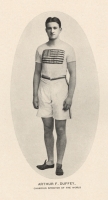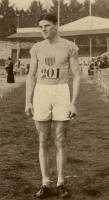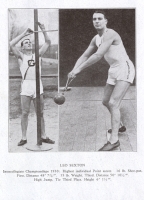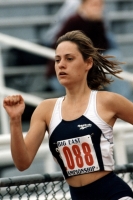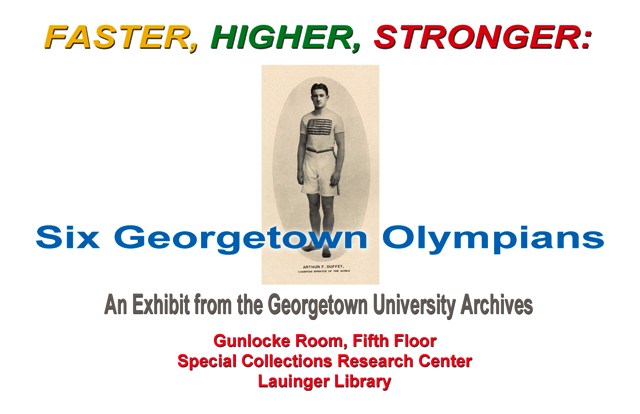
In honor of the 2012 Summer Olympic Games, the Georgetown University Archives takes a look back at six Georgetown athletes who went for gold.
Arthur Francis Duffy (L 1903). Competed in sprint events at the 1900 Paris Olympics. Pictured in Hodge Podge (Yearbook), 1904.
Born in Boston, Duffy was one of the greatest athletes to attend Georgetown. He held several different national and world records at various times and became known throughout the country as the world’s fastest man. At the time of the Paris Games, he held the world record for the 120 meters at 11 4/5 seconds. By far the favorite to win the 100 meters, he pulled a tendon and fell while in the lead during the Olympic final. He did not finish and was subsequently unable to compete in the 60 meter dash which he had also been expected to win. After retiring as a competitive runner, he joined the sports staff of The Boston Post.
Robert L. LeGendre (C 1922, D 1927). Competed in the pentathlon and decathlon at the 1920 Antwerp Olympics; bronze medalist in the pentathlon at 1924 Paris Olympics. Pictured in his 1920 Olympic uniform in Ye Domesday Booke, 1921.
One of the greatest all-round athletes to represent the University, LeGendre was the mainstay of the Georgetown track team during his undergraduate years. In 1920, he was the National Pentathlon Champion. He also accumulated the largest points total in the Inter-Allied Athletic Games held in Paris at the end of World War I. On April 10, 1920, he broke his leg but still qualified for the pentathlon and decathlon at the Olympic tryouts. At the Games, he finished in a tie for third in the pentathlon with Hugo Lahtinen of Finland, despite that fact that his leg was not fully healed. Scoring according to percentage tables gave Lahtinen third place and LeGendre fourth.
Although he had done little training since his graduation in 1922 while he considered an acting career, LeGendre again qualified for the Olympics in 1924. He placed third in the Pentathlon, setting a world record for the broad jump of 25 feet 6 inches in the process.
Leo Sexton (C 1930). Gold Medalist in the shot put at the 1932 Los Angeles Olympics. Pictured in the program from the Annual Varsity Dinner, May 8, 1930.
Leo Sexton, Georgetown’s sole representative at the 1932 games, was 6 foot 4 inches tall and weighed 230 lbs. A good high jumper, discus thrower, and decathlete, it was as a shot putter that he truly excelled, winning the Amateur Athletic Union National Shot Put Championships in 1931, 1932, and 1933. To qualify for the Olympics, he tossed the shot a distance of 52 feet 8 5/8 inches, exceeding the existing world record by half an inch. He won the shot event in Los Angeles with an Olympic record of 52 feet 6 3/16 inches.
Tony Johnson, Head Heavyweight Crew Coach, 1966-1969, and Head Crew Coach, 1989-Present. Silver medalist in the pair-oared-shell-without-coxswain at the 1968 Mexico City Olympics. “Johnson Finishes Training; Girds For Olympic Games.” The Hoya, 10/10/1968.
A native of Arlington, Virginia, Johnson rowed for Syracuse during his college career. He represented the U.S. with Jim Edmunds in the Tokyo Olympics in 1964 and finished tenth. In 1967, he and partner Larry Hough, an ensign in the Navy, became U.S., Pan American, and European Champions. They were favored to win gold at Mexico City but rowed to a silver medal. Johnson, Georgetown’s first Olympic competitor in a non‑track and field event, was phlegmatic about his silver medal saying in another of his articles for The Hoya that: Larry and I rowed a good race and we have no complaints or excuses.
From 1969-1989, Johnson served as crew coach at Yale. His squads there won several major championships, including the national title in 1982. He was named Eastern Coach of the Year the same year.
Patrick A. Ewing (C 1985). Gold medalist in Men’s Basketball at the 1984 Los Angeles Olympics and the 1992 Barcelona Olympics. Pictured playing for Georgetown in the 1984 NCAA Tournament.
As a freshman in 1982, center Patrick Ewing helped Georgetown to the NCAA finals. As a junior, he won gold at the 1984 Olympics, as a member of the U.S. basketball team coached by Bobby Knight of Indiana University. The team’s average margin of victory was 32 points and they beat Spain in the final by a score of 97 to 49.
For Ewing, Olympic victory followed Georgetown’s first NCAA Championship on April 2, 1984, and he became only the sixth American to achieve both feats in the same year: the others being Kansas’ Clyde Lovellete (1952); San Francisco’s Bill Russell and K.C. Jones (1956); Ohio State’s Jerry Lucas (1960) and Indiana’s Quinn Buckner (1976).
In 1992, Ewing won his second Olympic gold medal as part of the first U.S. Olympic basketball team to include NBA players. He is the only Hoya to win two Olympic gold medals.
Aimee Erin Mullins (F 1998). Competed in the long jump and sprint events at the 1996 Atlanta Paralympics. Pictured competing in the Big East Championships.
A member of the 1996 Georgetown women’s track and field team, Mullins was the national women’s disabled record holder for class TY3 (double below-knee amputees) in the 100 and 200 meters and long jump. She received BIG EAST Academic All-Star Team honors for the 1995-1996 season.
The Paralympics are the Olympic-equivalent games for athletes with physical disabilities. Behind the Olympics, it is the world’s second largest sporting event.
Curated by Lynn Conway, University Archivist

